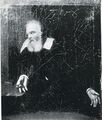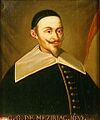Template:Selected anniversaries/February 26: Difference between revisions
No edit summary |
No edit summary |
||
| (36 intermediate revisions by the same user not shown) | |||
| Line 1: | Line 1: | ||
<gallery> | <gallery> | ||
| | File:Galileo E pur si muove.jpg|link=Galileo Galilei (nonfiction)|1616: Physicist and engineer [[Galileo Galilei (nonfiction)|Galileo Galilei]] is formally banned by the Roman Catholic Church from teaching or defending the view that the earth orbits the sun. | ||
| | |||
File:Claude Gaspard Bachet de Méziriac.jpg|link=Claude Gaspard Bachet de Méziriac (nonfiction)|1638: Mathematician and linguist [[Claude Gaspard Bachet de Méziriac (nonfiction)|Claude Gaspard Bachet de Méziriac]] dies. He was the earliest writer who discussed the solution of indeterminate equations by means of continued fractions. He also did work in number theory and found a method of constructing magic squares. | File:Claude Gaspard Bachet de Méziriac.jpg|link=Claude Gaspard Bachet de Méziriac (nonfiction)|1638: Mathematician and linguist [[Claude Gaspard Bachet de Méziriac (nonfiction)|Claude Gaspard Bachet de Méziriac]] dies. He was the earliest writer who discussed the solution of indeterminate equations by means of continued fractions. He also did work in number theory and found a method of constructing magic squares. | ||
File: | File:François Arago.jpg|link=François Arago (nonfiction)|1786: Mathematician and politician [[François Arago (nonfiction)|François Arago]] born. He will observe that a rotating plate of copper tends to communicate its motion to a magnetic needle suspended over it, an effect which will later be known as eddy current. | ||
| | File:Angelo_Secchi.jpg|link=Angelo Secchi (nonfiction)|1878: Astronomer and Jesuit priest [[Angelo Secchi (nonfiction)|Angelo Secchi]] dies. Secchi was a pioneer in astronomical spectroscopy, and was one of the first scientists to state authoritatively that the Sun is a star. | ||
| | |||
| | |||
File:Jef Raskin holding Canon Cat model.png|link=Jef Raskin (nonfiction)|2005: Computer scientist [[Jef Raskin (nonfiction)|Jef Raskin]] dies. He was a human–computer interface expert best known for conceiving and starting the Macintosh project for Apple in the late 1970s. | File:Jef Raskin holding Canon Cat model.png|link=Jef Raskin (nonfiction)|2005: Computer scientist [[Jef Raskin (nonfiction)|Jef Raskin]] dies. He was a human–computer interface expert best known for conceiving and starting the Macintosh project for Apple in the late 1970s. | ||
</gallery> | </gallery> | ||
Latest revision as of 10:02, 26 February 2022
1616: Physicist and engineer Galileo Galilei is formally banned by the Roman Catholic Church from teaching or defending the view that the earth orbits the sun.
1638: Mathematician and linguist Claude Gaspard Bachet de Méziriac dies. He was the earliest writer who discussed the solution of indeterminate equations by means of continued fractions. He also did work in number theory and found a method of constructing magic squares.
1786: Mathematician and politician François Arago born. He will observe that a rotating plate of copper tends to communicate its motion to a magnetic needle suspended over it, an effect which will later be known as eddy current.
1878: Astronomer and Jesuit priest Angelo Secchi dies. Secchi was a pioneer in astronomical spectroscopy, and was one of the first scientists to state authoritatively that the Sun is a star.
2005: Computer scientist Jef Raskin dies. He was a human–computer interface expert best known for conceiving and starting the Macintosh project for Apple in the late 1970s.




